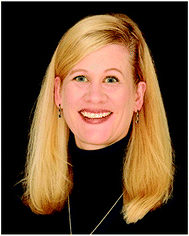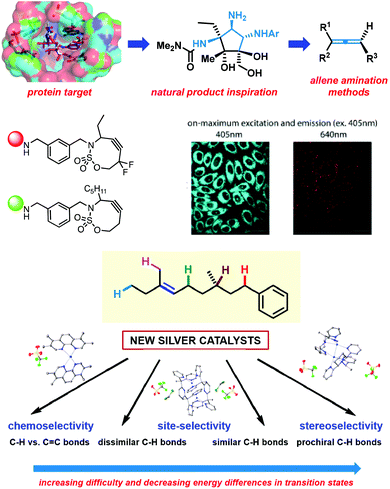DOI: 10.1039/C9QO90111F
(Profile)
Org. Chem. Front., 2020, 7, 442-444
Interview with Jennifer M. Schomaker
Department of Chemistry, 1101 University Avenue, Madison, WI 53706. E-mail: schomakerj@chem.wisc.edu; Web: https://schomaker.chem.wisc.edu/
Received
13th December 2019
, Accepted 13th December 2019
What inspired you to choose science and eventually become a chemist in the first place?
Having completed all available science courses in my first two years of high school, I was fortunate to have dedicated STEM teachers who offered me numerous opportunities to carry out independent projects. I realized learning went far beyond the material in textbooks, gained the confidence to recognize failure was just a step on the way to success, and experienced the thrill of designing and analyzing my own experiments. I hope I convey this same enthusiasm to my own students at all levels!What do you think are the most interesting parts of your research work?
The ability to work in academia has provided my students and I with myriad opportunities to move outside our scientific comfort zones. While I still rely on my training in synthesis and methods development, the ability to apply these skills to address problems across a broad range of disciplines is one of the most interesting aspects of my work. When I started at Wisconsin, I never envisaged we would computationally design silver catalysts for tunable nitrene transfer, develop new bioorthogonal labeling reagents, or work on molecules for light-activated electrophysiology. The twists and turns provided by a research-based career have been both immensely challenging and rewarding!How do you usually spend your time outside research work?
Our family loves nature and spending time out-of-doors, so I can usually be found hiking, canoeing, climbing, gardening, or biking when I′m not at work. I find many of my best ideas occur to me when I′m relaxed and free to think only about science.What are your suggestions for the younger generation to encourage them to consider a career in science?
On a societal level, pursuing a career in science gives one the necessary tools to productively address a host of challenges that impact our world, from clean water, food production, human health, renewable energy, and beyond. On a personal level, having a career where learning, discovery, and exercise of creativity are everyday occurrences is one of the most satisfying that I can imagine. In addition, the chance to work with talented colleagues from all over the world and across many disciplines provide continual intellectual and personal growth.References
- M. Ju, M. Huang, L. E. Vine, J. M. Roberts, M. Dehghany and J. M. Schomaker, Tunable, catalyst-controlled syntheses of β- and γ-amino alcohol motifs enabled by silver complexes, Nat. Catal., 2019, 2, 899–908 CrossRef CAS.
- K. A. Nicastri, J. Eshon, S. C. Schmid, W. Raskop, I. A. Guzei, I. Fernández and J. M. Schomaker, Intermolecular [3 + 3] Ring-Expansion of Aziridines to Dehydropiperidines through the Intermediacy of Aziridinium Ylides, Nat. Commun., 2019 Search PubMed , under review.
- S. C. Schmid, I. A. Guzei, I. Fernández and J. M. Schomaker, Ring expansion of bicyclic methyleneaziridines via concerted, near-barrierless [2,3]-Stevens rearrangements of aziridinium ylides, ACS Catal., 2018, 8, 7907–7914 CrossRef CAS PubMed.
- M. Huang, T. Yang, J. Paretsky, J. F. Berry and J. M. Schomaker, Inverting Steric Effects: Using ‘Attractive’ Non-Covalent Interactions to Direct Silver-Catalyzed Nitrene Transfer, J. Am. Chem. Soc., 2017, 139, 17376–17386 CrossRef CAS PubMed.
- S. C. Schmid and J. M. Schomaker, A Stereoselective Ring Expansion of the Synthesis of Highly-Substituted Methylene Azetidines, Angew. Chem., Int. Ed., 2017, 56, 12229–12233 CrossRef CAS PubMed.
- M. Ju, C. D. Weatherly, I. A. Guzei and J. M. Schomaker, Chemo- and enantioselective silver-catalyzed aziridinations, Angew. Chem., Int. Ed., 2017, 56, 9944–9948 CrossRef CAS PubMed.
- E. G. Burke, B. Gold, T. T. Hoang, R. T. Raines and J. M. Schomaker, Fine-tuning Strain and Electronic Activation of Strain-promoted 1,3-Dipolar Cycloaddition with Endocyclic Sulfamates in SNO-OCTs, J. Am. Chem. Soc., 2017, 139, 8029–8037 CrossRef CAS PubMed.
- N. Dolan, R. Scamp, T. Yang, J. F. Berry and J. M. Schomaker, Catalyst-controlled and tunable, chemoselective silver-catalyzed intermolecular nitrene transfer: Experimental and computational studies, J. Am. Chem. Soc., 2016, 138, 14658–14667 CrossRef CAS PubMed.
- R. Van Hoveln, B. Hudson, H. Wedler, D. M. Bates, G. Le Gros, D. Tantillo and J. M. Schomaker, Experimental and Computational Insights into the Mechanism of Cu-catalyzed 1,3-Halogen Migration, J. Am. Chem. Soc., 2015, 137, 5346–5354 CrossRef CAS PubMed.
- R. Scamp, J. M. Alderson, A. M. Phelps, N. Dolan and J. M. Schomaker, Ligand-controlled, tunable silver-catalyzed C-H amination, J. Am. Chem. Soc., 2014, 136, 16720–16723 CrossRef PubMed.
- J. W. Rigoli, C. D. Weatherly, J. M. Alderson, B. Vo and J. M. Schomaker, Tunable, Chemoselective Amination via, Silver Catalysis, J. Am. Chem. Soc., 2013, 135, 17238–17241 CrossRef CAS PubMed.
- R. D. Grigg, R. Van Hoveln and J. M. Schomaker, Cu-catalyzed recycling of halogen activating groups via 1,3-halogen migration, J. Am. Chem. Soc., 2012, 134, 16131–16134 CrossRef CAS PubMed.
- C. S. Adams, L. A. Boralsky, I. A. Guzei and J. M. Schomaker, Modular functionalization of allenes to aminated stereotriads, J. Am. Chem. Soc., 2012, 134, 10807–10810 CrossRef CAS PubMed.
| This journal is © the Partner Organisations 2020 |


